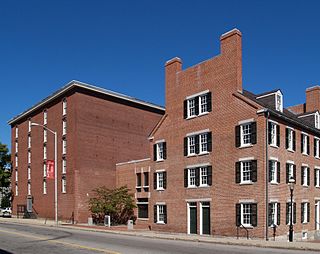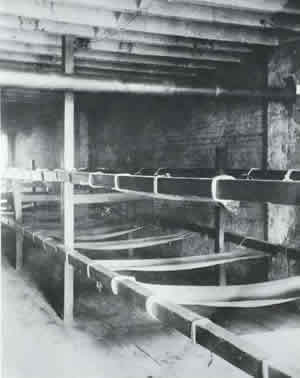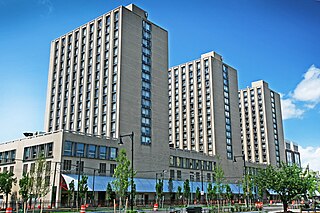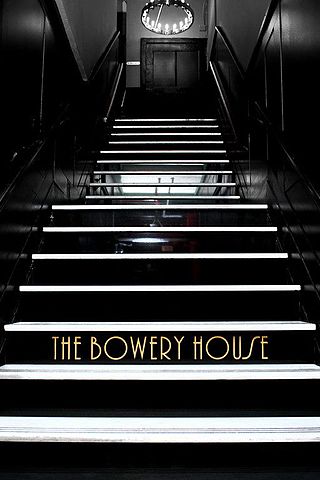
An apartment, flat, or unit is a self-contained housing unit that occupies part of a building, generally on a single storey. There are many names for these overall buildings. The housing tenure of apartments also varies considerably, from large-scale public housing, to owner occupancy within what is legally a condominium, to tenants renting from a private landlord.

A boarding house is a house in which lodgers rent one or more rooms on a nightly basis, and sometimes for extended periods of weeks, months, and years. The common parts of the house are maintained, and some services, such as laundry and cleaning, may be supplied. They normally provide "room and board," that is, some meals as well as accommodation.

A bedroom or bedchamber is a room situated within a residential or accommodation unit characterised by its usage for sleeping and sexual activity. A typical western bedroom contains as bedroom furniture one or two beds, a clothes closet, and bedside table and dressing table, both of which usually contain drawers. Except in bungalows, ranch style homes, ground floor apartments, or one-storey motels, bedrooms are usually on one of the floors of a dwelling that is above ground level. Beds range from a crib for an infant; a single or twin bed for a toddler, child, teenager or single adult; to bigger sizes like a full, double, queen, king or California king). Beds and bedrooms are often devised to create barriers to insects and vermin, especially mosquitoes, and to dampen or contain light or noise to aid sleep and privacy.

A flophouse or doss-house is a place that offers very low-cost lodging, providing space to sleep and minimal amenities.

An ice hotel is a temporary hotel made up of snow and sculpted blocks of ice. Ice hotels, dependent on sub-freezing temperatures, are constructed from ice and snow and typically have to be rebuilt every year. Ice hotels exist in several countries, and they have varying construction styles, services and amenities, the latter of which may include ice bars, restaurants, chapels, saunas and hot tubs.

Single room occupancy is a form of housing that is typically aimed at residents with low or minimal incomes, or single adults who like a minimalist lifestyle, who rent small, furnished single rooms with a bed, chair, and sometimes a small desk. SRO units are rented out as permanent residence and/or primary residence to individuals, within a multi-tenant building where tenants share a kitchen, toilets or bathrooms. SRO units range from 7 to 13 square metres. In some instances, contemporary units may have a small refrigerator, microwave, or sink.

Mills House No. 1 or the Mills Hotel at 160 Bleecker Street in Greenwich Village, Manhattan, New York City was built as a hotel for poor men. It was funded by banker Darius Ogden Mills and designed by Ernest Flagg and opened in 1897. The building is now The Atrium.

The Boston University housing system is the 2nd-largest of any private university in the United States, with 76% of the undergraduate population living on campus. On-campus housing at BU is an unusually diverse melange, ranging from individual 19th-century brownstone town houses and apartment buildings acquired by the school to large-scale high-rises built in the 60s and 2000s.

A rooming house, also called a "multi-tenant house", is a "dwelling with multiple rooms rented out individually", in which the tenants share kitchen and often bathroom facilities. Rooming houses are often used as housing for low-income people, as rooming houses are the least expensive housing for single adults. Rooming houses are usually owned and operated by private landlords. Rooming houses are better described as a "living arrangement" rather than a specially "built form" of housing; rooming houses involve people who are not related living together, often in an existing house, and sharing a kitchen, bathroom, and a living room or dining room. Rooming houses in this way are similar to group homes and other roommate situations. While there are purpose-built rooming houses, these are rare.

An apartment hotel or aparthotel is a serviced apartment complex that uses a hotel-style booking system. It is similar to renting an apartment, but with no fixed contracts and occupants can "check out" whenever they wish, subject to the applicable minimum length of stay imposed by the company.

The Jane is a boutique hotel at 505–507 West Street, on the northeastern corner with Jane Street, in the West Village neighborhood of Manhattan in New York City. It was constructed in 1908 by the American Seaman's Friend Society (ASFS) as a sailors' boarding house called the American Seamen's Friend Society Sailors' Home and Institute. The Jane was designed by William A. Boring in the Georgian style and is a New York City designated landmark.
The McCormick Road Dormitories are one of two main areas of first-year living dormitories at the University of Virginia, the other being the Alderman Road Dormitories. Ten houses make up the residence area located on McCormick Road. The dormitory area was constructed in 1950 and holds nearly 1300 students. Although older and lacking in modern amenities compared to "New Dorms," Old Dorms are closer to Central Grounds and contain larger rooms.
The Gulf Hotel fire claimed 55 lives in the early-morning hours of September 7, 1943 in Downtown Houston, Texas, United States. The fire remains the worst loss of life in a fire in the city's history.

The Bowery House is an historic hotel on the Bowery in Manhattan, New York City, that mimics its former incarnation as a flophouse.

The Arcadia Hotel fire occurred on December 3, 1913 in a flophouse on the corner of Washington and Laconia Streets in Boston's South End. The fire killed 28 persons, making it the deadliest in Boston at that time, passing the Great Boston Fire of 1872.

Benburb Street is a street in Dublin, Ireland.

Bride Road is a street in the medieval area of Dublin, Ireland.

Lodgers in Bayard Street Tenement, Five Cents a Spot is a black and white photograph taken by Danish American photographer Jacob Riis, in 1889. It was included in his photographic book How the Other Half Lives, published in 1890.



















